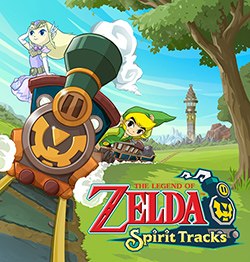The Legend of Zelda: Spirit Tracks
| The Legend of Zelda: Spirit Tracks | |
|---|---|

North American box art
|
|
| Developer(s) | Nintendo EAD |
| Publisher(s) | Nintendo |
| Director(s) | Daiki Iwamoto |
| Producer(s) | Eiji Aonuma |
| Artist(s) |
|
| Composer(s) |
|
| Series | The Legend of Zelda |
| Platform(s) | Nintendo DS |
| Release | |
| Genre(s) | Action-adventure |
| Mode(s) | Single-player, multiplayer |
| Aggregate scores | |
|---|---|
| Aggregator | Score |
| GameRankings | 86.92% |
| Metacritic | 87/100 |
| Review scores | |
| Publication | Score |
| 1UP.com | A- |
| CVG | 9.1/10 |
| Eurogamer | 9/10 |
| Game Informer | 8/10 |
| Game Revolution | A- |
| GameSpot | 8.5/10 |
| GameSpy | |
| GamesRadar | 9/10 |
| GameTrailers | 9/10 |
| IGN | 9.3/10 |
| Nintendo World Report | 9/10 |
| ONM | 91% |
| PALGN | 9/10 |
| VideoGamer.com | 8/10 |
The Legend of Zelda: Spirit Tracks (Japanese: ゼルダの伝説 大地の汽笛 Hepburn: Zeruda no Densetsu: Daichi no Kiteki?, The Legend of Zelda: Train Whistle of the Wide World) is an action-adventure game developed and published by Nintendo for the Nintendo DS handheld game console. An installment in the The Legend of Zelda series, it was released worldwide in December 2009.
Like its prequels The Legend of Zelda: The Wind Waker and The Legend of Zelda: Phantom Hourglass, The Legend of Zelda: Spirit Tracks features a cel-shaded art style.Link, the protagonist of Spirit Tracks, travels across the game's overworld using a cannon-equipped steam train much like the steamboat in Phantom Hourglass. The player is also able to control Phantoms, and play an instrument known as the Spirit Flute.
Spirit Tracks continues its style of gameplay from The Legend of Zelda: Phantom Hourglass, in which players use the stylus to control Link and use his assortment of weapons, items, and vehicle albeit with a few game play tweaks. The game is divided into an overworld, which Link traverses using the Spirit Tracks, and towns and dungeons which he travels by foot. The player alternates between moving about the overworld/underwater and exploring towns and dungeons in order to complete the game's main story, but may opt to take in side quests for further rewards. In both the overworld and dungeons, the player is able to make notes on their current map as an aid in puzzle solving, for further reference, and continuing the story.
...
Wikipedia
